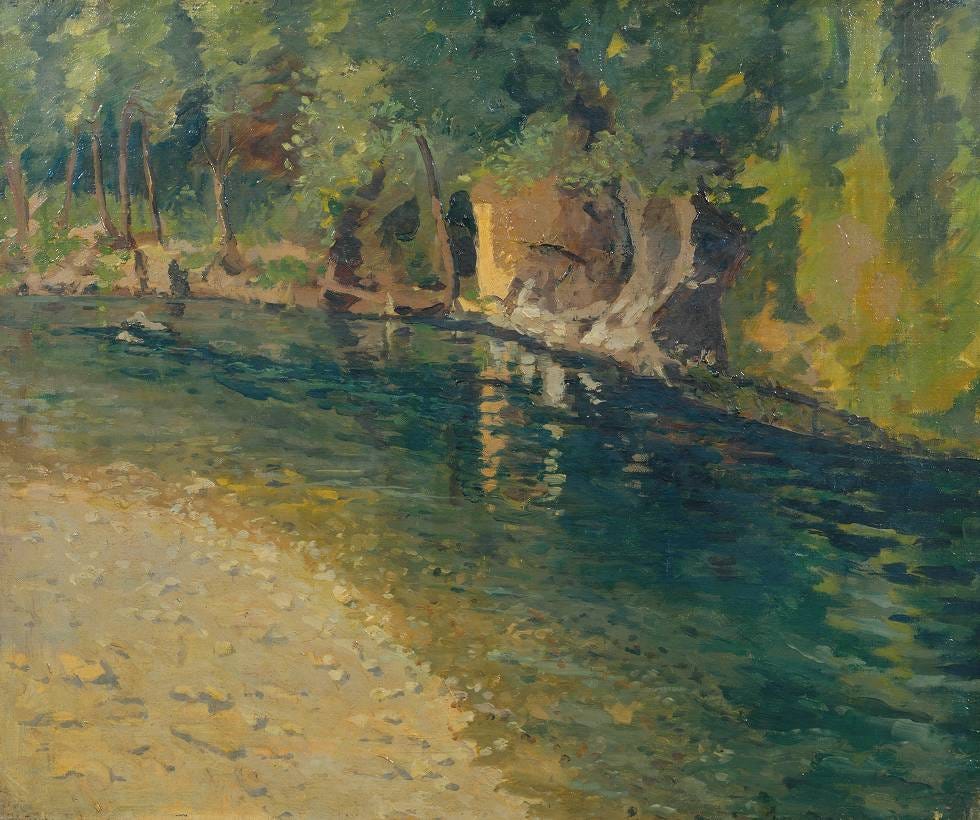THE RIVER OF RIVERS IN CONNECTICUT
There is a great river this side of Stygia
Before one comes to the first black cataracts
And trees that lack the intelligence of trees.
In that river, far this side of Stygia,
The mere flowing of the water is a gayety,
Flashing and flashing in the sun. On its banks,
No shadow walks. The river is fateful,
Like the last one. But there is no ferryman.
He could not bend against its propelling force.
It is not to be seen beneath the appearances
That tell of it. The steeple at Farmington
Stands glistening and Haddam shines and sways.
It is the third commonness with light and air,
A curriculum, a vigor, a local abstraction . . .
Call it, one more, a river, an unnamed flowing,
Space-filled, reflecting the seasons, the folk-lore
Of each of the senses; call it, again and again,
The river that flows nowhere, like a sea.
Wallace Stevens
RIVER
The Nile, the Ganges, the Tigris, the Euphrates, the Amazon... all civilizations have their own river, their source of life. A river is the image of human existence: it’s born at the top of the mountains, meanders, grows, gets strong, calms, makes a great leap, bifurcates, takes more force, takes cruising speed and, eventually, dies at sea. Fluidness is the essential quality of rivers. The descent into the ocean represents the journey towards dissolution, the final union with death. Plunging a river like the salmon or Captain Willard at Apocalypse Now is a return to the beginning of creation, to the origins. Crossing a river is a powerful image, the shores usually incarnate two opposite worlds. For the Greeks it was the border between the living and the dead. In ancient China, young couples crossed a river at the spring equinox in a purifying passage ritual: a call to rain, to the restoration of yang, to the fertilization of the earth. The two riverbeds can also symbolize consciousness and unconsciousness. The names of the rivers of Hell from Greek mythology indicate the torments that await the condemned: Acheron (pain and sadness), Phlegethon (burns, Flegethon means "flaming"), Cocytus (regrets), Stix (hate and horror) and Lethe (oblivion). In many cultures, the river represents the inexorable passage of time. The river is the vital fluidity that connects the upper world to the lower world in a perpetual and cyclic motion. Heraclitus spoke of a steady stream, nothing is still, and we can never bathe in the same river. Not only because the river changes, we —human beings— are also a permanent transformation.
“Life can only be understood backwards; but it must be lived forwards.” Søren Kierkegaard
EL RIU DELS RIUS A CONNECTICUT
Hi ha un gran riu a aquesta banda de l’Estígia,
abans d’arribar a les primeres cascades negres
i als arbres mancats de la intel·ligència dels arbres.
En aquell riu, lluny d’aquesta banda de l’Estígia,
el mer fluir de les aigües és una joia,
que ara i adés resplendeix al sol. Pels marges
no hi camina cap ombra. El riu és fatídic,
com ho és l’últim riu. Però no hi ha barquer.
No podria inclinar-se contra la força impulsora.
El riu no ha de ser vist sota aparences
que el descriuen. Els campanars de Farmington
s’alcen entre lluïssors i Haddam brilla i es gronxa.
És el tercer element comú a l’aigua i l’aire,
un currículum, un vigor, una abstracció…
Digueu-li, de nou, un riu, un fluir sense nom
que s’omple d’espai i reflecteix estacions, el folk-lore
de cadascun dels sentits; digueu-li, ara un cop, ara un altre,
el riu que flueix cap a enlloc, com un mar.
Wallace Stevens (traduït per Josep M. Capilla)
RIU
El Nil, el Ganges, el Tigris, l’Èufrates, l’Amazones… totes les civilitzacions tenen el seu riu, la seva font de vida. El riu és la imatge de l’existència humana: neix al cim de les muntanyes, serpenteja, creix, agafa força, es calma, fa un gran salt, torna a agafar més força, es bifurca, agafa velocitat de creuer i, finalment, mor al mar. La fluïdesa és la qualitat essencial dels rius. El descens a l’oceà representa el viatge cap a la dissolució, la unió final amb la mort. Pujar un riu com fan els salmons o el capità Willard a Apocalypse Now és un retorn als inicis de la creació, als orígens. Creuar un riu és una imatge poderosa, les ribes solen encarnar dos mons oposats. Pels grecs era la frontera entre els vius i els morts. A la Xina antiga, les parelles joves travessaven un riu a l’equinocci primaveral en un ritual de pas purificador: una crida a la pluja, a la restauració del yang, a la fecundació de la terra. Les dos lleres d’un riu també poden simbolitzar la consciència i l'inconscient. Els noms dels rius de l’infern de la mitologia grega indiquen els turments que esperen als condemnats: l’Aqueront (dolor i tristesa), el Flegetont (cremades, Flegethon vol dir "que flambeja"), el Cocit (laments), l’Estigía (odi i horror) i el Leteu (oblit). Cada riu de l’Hades donaria per escriure una pàgina sencera. En multitud de cultures, el riu representa l’inexorable pas del temps. El riu és la fluidesa vital que connecta el món superior amb l'inferior en un moviment perpetu i cíclic. Heràclit parlava d’un fluir constant, res està quiet ni podem banyar-nos mai en el mateix riu. No només perquè el riu canvia, també nosaltres —els éssers humans— som una transformació permanent.
“La vida només es pot entendre mirant enrere, però només es pot viure mirant endavant.”
Søren Kierkeggard









